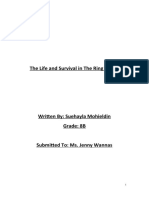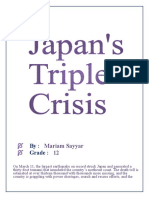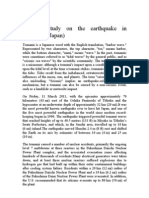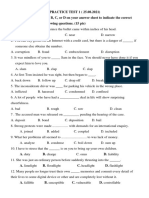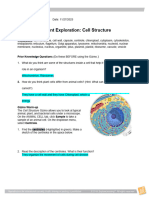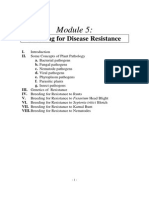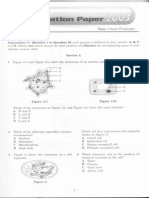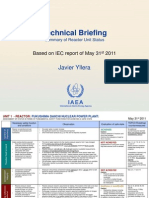The Asia-Pacific Journal: Japan Focus: In-Depth Critical Analysis of The Forces Shaping The Asia-Pacific... and The World
The Asia-Pacific Journal: Japan Focus: In-Depth Critical Analysis of The Forces Shaping The Asia-Pacific... and The World
Uploaded by
Dewi SekarsariCopyright:
Available Formats
The Asia-Pacific Journal: Japan Focus: In-Depth Critical Analysis of The Forces Shaping The Asia-Pacific... and The World
The Asia-Pacific Journal: Japan Focus: In-Depth Critical Analysis of The Forces Shaping The Asia-Pacific... and The World
Uploaded by
Dewi SekarsariOriginal Description:
Original Title
Copyright
Available Formats
Share this document
Did you find this document useful?
Is this content inappropriate?
Copyright:
Available Formats
The Asia-Pacific Journal: Japan Focus: In-Depth Critical Analysis of The Forces Shaping The Asia-Pacific... and The World
The Asia-Pacific Journal: Japan Focus: In-Depth Critical Analysis of The Forces Shaping The Asia-Pacific... and The World
Uploaded by
Dewi SekarsariCopyright:
Available Formats
The Nuclear Disast er That Could Dest roy Japan On t he danger of a killer eart hquake in t he
Japanese Archipelago
Hi rose T akashi
T ransl at ed and wi t h an i nt roduct i on by C. Dougl as Lummi s
T he ori gi nal Japanese t ext i s avai l abl e here.
Translators note
(Nucl ear) Power Corrupt s
A puzzle for our time: how is it possible for a person to be smart enough to make plutonium, and dumb enough actually to make it?
Plutonium has a half life of 24,000 years, which means that in that time its toxicity will be reduced by half. What could possess a
person, who will live maybe one three-hundredth of that time, to produce such a thing and leave it to posterity to deal with? In fact,
possess might be the right word. Behind all the nuclear power industrys language of cost efficiency or liberation from fossil fuel
or whatever, one can sense a kind of possession a bureaucratized madness. Political science has produced but one candidate for
a scientific law - Power Corrupts and Absolute Power Corrupts Absolutely. But the political scientists havent noticed that the closest
thing we have to absolute power is nuclear power. Nuclear power corrupts in a peculiar way. It seems to tempt the engineers into
imagining they have been raised to a higher level, a level where common sense judgments are beneath them. Judgments like (as my
grandmother used to say) Accidents do happen.
At their press conferences, the Tokyo Electric Co. (Tepco) officials say, as if it were an excuse, that the 3/11 earthquake and tsunami
in northeastern Japan were outside their expectations. Look it up in the dictionary; thats the definition of accident. For decades
common-sense opponents of nuclear power, in Japan and all over the world, have been asking the common-sense question, What if
there is an accident? For this they were ridiculed and scorned by the nuclear engineers and their spokespersons. We, suffer an
accident? In our world there are no accidents!
Playing with nuclear power is playing God, which is by far the most corrupting game of all.
In Japan, one of the loudest, most persistent and best informed of the voices asking this common sense question has been that of
Hirose Takashi. Mr. Hirose first came into public view with a Swiftean satire he published in 1981, Tokyo e, Genpatsu wo! (Nuclear
Power Plants to Tokyo!).(Shueisha) In that work, he made the argument that, if it is really true that these plants are perfectly safe
(accidents never happen) then why not build them in downtown Tokyo rather than in far-off places? By putting them so far away
you lose half the electricity in the wires, and waste all that hot water by pumping it into the ocean instead of delivering it to peoples
homes where it could be used for baths and cooking. The book outraged a lot of people especially in Tokyo and revealed the
hypocrisy of the safety argument.
In the years since then he has published volume after volume on the nuclear power issue particularly focusing on the absurdity of
building a facility that requires absolutely no accidents whatsoever, on an archipelago famous as the earthquake capital of the
world. Again and again he made frightening predictions which (as he writes in the introduction to his latest book Fukushima Meltdown
(Asahi, 2011) he was always praying would prove wrong. Tragically, they did not. In the present article he reminds readers that the
recent earthquake was not the last, but one in a series, and that the situation at Japans other nuclear power plants is as dangerous
as ever. The nuclear power industry would like us to believe the 3/11 catastrophe was an exception. But all accidents are
exceptions as will be the next. CDL
C. Douglas Lummis is the author of Radical Democracy and other books in Japanese and English. A Japan Focus associate, he formerly taught at
Tsuda College.
Eart hquakes and Nucl ear Power Pl ant s
The nuclear power plants in Japan are ageing rapidly; like cyborgs, they are barely kept in operation by a continuous replacement of
parts. And now that Japan has entered a period of earthquake activity and a major accident could happen at any time, the people live
in constant state of anxiety.
Seismologists and geologists agree that, after some fifty years of seismic inactivity, with the 1995 Hanshin-Awaji Earthquake
(Southern Hyogo Prefecture Earthquake), the country has entered a period of seismic activity. In 2004, the Chuetsu Earthquake hit
Niigata Prefecture, doing damage to the village of Yamakoshi. Three years later, in 2007, the Chuetsu Offshore Earthquake severely
damaged the nuclear reactors at Kashiwazaki-Kariwa. In 2008, there was an earthquake in Iwate and Miyagi Prefectures, causing a
whole mountain to disappear completely. Then in 2009 the Hamaoka nuclear plant was put in a state of emergency by the Suruga
Bay Earthquake. And now, in 2011, we have the 3/11 earthquake offshore from the northeast coast. But the period of seismic
activity is expected to continue for decades. From the perspective of seismology, a space of 10 or 15 years is but a moment in time.
Because the Pacific Plate, the largest of the plates that envelop the earth, is in motion, I had predicted that there would be major
earthquakes all over the world.
And as I had feared, after the Suruga Bay Earthquake of August 2009 came as a triple shock, it was followed in September and
October by earthquakes off Samoa, Sumatra, and Vanuatu, of magnitudes between 7.6 and 8.2. That means three to eleven times
the force of the Southern Hyogo Prefecture Earthquake. As you can see in the accompanying chart, all of these quakes occurred
around the Pacific Plate as the center, and each was located at the boundary of either that plate or a plate under its influence. Then
in the following year, 2010, in January there came the Haiti Earthquake, at the boundary of the Caribbean Plate, pushed by the Pacific
and Coco Plates, then in February the huge 8.8 magnitude earthquake offshore from Chile. I was praying that this world scale series
The Asia-Pacific Journal: Japan Focus
In-depth critical analysis of the forces shaping the Asia-Pacific...and the world.
of earthquakes would come to an end, but the movement of the Pacific
Plate shows no sign of stopping, and led in 2011 to the 3/11 Earthquake
in northeastern Japan and the subsequent meltdown at the Fukushima
Nuclear Plant.
Is t he Rokkasho Reprocessi ng Pl ant Saf e?
There are large seismic faults, capable of producing earthquakes at the 7
or 8 magnitude level, near each of Japans nuclear plants, including the
reprocessing plant at Rokkasho. It is hard to believe that there is any
nuclear plant that would not be damaged by a magnitude 8 earthquake.
A
representative case is the Rokkasho Reprocessing Plant itself, where it has become clear that the fault under the sea nearby also
extends inland. The Rokkasho plant, where the nuclear waste (death ash) from all the nuclear plants in Japan is collected, is located
on land under which the Pacific Plate and the North American Plate meet. That is, the plate that is the greatest danger to the
Rokkasho plant, is now in motion deep beneath Japan.
The Rokkasho plant was originally built with the very low earthquake resistance factor of 375 gals. (Translators note: The gal, or
galileo, is a unit used to measure peak ground acceleration during earthquakes. Unlike the scales measuring an earthquakes
general intensity, it measures actual ground motion in particular locations.) Today its resistance factor has been raised to only 450
gals, despite the fact that recently in Japan earthquakes registering over 2000 gals have been occurring one after another. Worse,
the Shimokita Peninsula is an extremely fragile geologic formation that was at the bottom of the sea as recently as the sea rise of
the Jomon period (the Flandrian Transgression) 5000 years ago; if an earthquake occurred there it could be completely destroyed.
The Rokkasho Reprocessing Plant is where expended nuclear fuel from all of Japans nuclear power plants is collected, and then
reprocessed so as to separate out the plutonium, the uranium, and the remaining highly radioactive liquid waste. In short, it is the
most dangerous factory in the world.
At the Rokkasho plant, 240 cubic meters of radioactive liquid waste are now stored. A failure to take care of this properly could lead
to a nuclear catastrophe surpassing the meltdown of a reactor. This liquid waste continuously generates heat, and must be
constantly cooled. But if an earthquake were to damage the cooling pipes or cut off the electricity, the liquid would begin to boil.
According to an analysis prepared by the German nuclear industry, an explosion of this facility could expose persons within a 100
kilometer radius from the plant to radiation 10 to 100 times the lethal level, which presumably means instant death.
On April 7, just one month after the 3/11 earthquake in northeastern Japan, there was a large aftershock. At the Rokkasho
Reprocessing Plant the electricity was shut off. The pool containing nuclear fuel and the radioactive liquid waste were (barely)
cooled down by the emergency generators, meaning that Japan was brought to the brink of destruction. But the Japanese media, as
usual, paid this almost no notice.
T he Hamaoka Nucl ear Pl ant and t he Approachi ng Ki l l er
Eart hquake
The Hamaoka Nuclear Plant is located at Shizuoka City, on Suruga Bay.
Despite predictions of a magnitude 8 earthquake on Suruga Bay, it has
continued in operation. If you look at the illustration showing the
configuration of the plates beneath the Pacific Ocean, you will see that
there is a point at which the Philippine Sea Plate, the huge Pacific Plate,
the North American Plate, and the Eurasian Plate all meet; directly over
that point is the Japanese Archipelago. And the very center of the area
where these four plates press together is Shizuoka.
As shown in the chart below, large scale earthquakes in the eastern and
southern seas have occurred regularly at intervals of between 100 and
250 years. Today in 2011, 157 years have passed since the Great Ansei
Earthquake of 1854, so we are in a period when the next big one could
come at any time. And the predicted center of this expected major
earthquake is though this is hard to believe exactly under the
location of the Hamaoka Nuclear Plant. (Editors note: On May 6, 2011,
following a request from Prime Minister Kan, the Hamaoka Plant was
temporarily closed in light of the prediction that there was an 87% chance that an earthquake of magnitude 8.0 or more would
strike the area in the next thirty years.)
And sonar readings at the site indicate that from thirty years back the Eurasian plate has been bending, which means that it is in a
condition where it can be expected eventually to spring back.
C. Douglas Lummis is the author of Radical Democracy and other books in Japanese and English. A Japan Focus associate, he formerly taught at
Tsuda College.
Recommended citation: Hirose Takashi and C. Douglas Lummis, The Nuclear Disaster That Could Destroy Japan On the danger of a killer
earthquake
in the
Japanese
Archipelago,
The Asia-
Pacific
Journal Vol
9, Issue 21
No 2, May
23, 2011.
Created
by
Datamomentum
You might also like
- Epp Grade 6 2nd Periodical ExamDocument5 pagesEpp Grade 6 2nd Periodical ExamAlmarieSantiagoMallabo91% (34)
- Jungle TreasuresDocument24 pagesJungle Treasuresjuan joel mendoza100% (3)
- HormoneKitRecipes PDFDocument15 pagesHormoneKitRecipes PDFDana NNo ratings yet
- Documentation - Tiraz Embroidered Towel - Egypt 14th C - CompleteDocument23 pagesDocumentation - Tiraz Embroidered Towel - Egypt 14th C - CompleteMaya Heath100% (2)
- Tem Paper 2nd DraftDocument10 pagesTem Paper 2nd Draftisc6123No ratings yet
- Japan Earthquake, Tsunami and Nuclear Crisis: / Nætʃ.ɚ. LD Ɪ Zæs - TɚDocument6 pagesJapan Earthquake, Tsunami and Nuclear Crisis: / Nætʃ.ɚ. LD Ɪ Zæs - TɚLillis SarahNo ratings yet
- Earthquake Case StudyDocument13 pagesEarthquake Case StudyShantanu Vashishtha100% (1)
- Japan's Deadly Game of Nuclear Roulette 2004-05-23 (!!!)Document6 pagesJapan's Deadly Game of Nuclear Roulette 2004-05-23 (!!!)GodIsTruthNo ratings yet
- 2013 10 01 Disasters Leadership RebuildingDocument20 pages2013 10 01 Disasters Leadership RebuildingJosé Francisco Fernández FernandezNo ratings yet
- By: Grade:: Mariam Sayyar 12Document4 pagesBy: Grade:: Mariam Sayyar 12Maryoom SalmanNo ratings yet
- Eastern Japan Earthquake TsunamiDocument6 pagesEastern Japan Earthquake TsunamiJeff JonesNo ratings yet
- Notebook 7Document3 pagesNotebook 7api-272707481No ratings yet
- J E Q D: APAN'S 2011 Arth Uake IsasterDocument3 pagesJ E Q D: APAN'S 2011 Arth Uake IsasterAzeem IqbalNo ratings yet
- Prophecy: Towards the Final Nuclear World War in 2015, Volume IFrom EverandProphecy: Towards the Final Nuclear World War in 2015, Volume INo ratings yet
- A Hole at the Bottom of the Sea: The Race to Kill the BP Oil GusherFrom EverandA Hole at the Bottom of the Sea: The Race to Kill the BP Oil GusherRating: 3.5 out of 5 stars3.5/5 (6)
- INFORMATIVE SPEECH by Kurstan Zoie N. FloresDocument1 pageINFORMATIVE SPEECH by Kurstan Zoie N. Flores:DNo ratings yet
- Antinuclear Citizens: Sustainability Policy and Grassroots Activism in Post-Fukushima JapanFrom EverandAntinuclear Citizens: Sustainability Policy and Grassroots Activism in Post-Fukushima JapanNo ratings yet
- YR9 Week 2 HomeworkDocument7 pagesYR9 Week 2 Homeworkmalekashrafomar2No ratings yet
- TsunamiDocument2 pagesTsunaminetplanetNo ratings yet
- Nuclear EnergyDocument3 pagesNuclear EnergyukhtiNo ratings yet
- Nie Essay JapanDocument1 pageNie Essay JapanNadirah IsmailNo ratings yet
- Energy: 2. "Geo" Means Earth, and "Thermal" Means Heat. SoDocument5 pagesEnergy: 2. "Geo" Means Earth, and "Thermal" Means Heat. Sowhite_vampire1No ratings yet
- Station Blackout: Inside the Fukushima Nuclear Disaster and RecoveryFrom EverandStation Blackout: Inside the Fukushima Nuclear Disaster and RecoveryRating: 3 out of 5 stars3/5 (1)
- Joy 2Document1 pageJoy 2kishanpatel3112No ratings yet
- Ecological DisastersDocument15 pagesEcological DisastersamartyaNo ratings yet
- Thesis About Tsunami in JapanDocument4 pagesThesis About Tsunami in Japanbsqjpnxd100% (1)
- Nuclear Energy - Ban or BoonDocument15 pagesNuclear Energy - Ban or BoonDip Patel100% (9)
- My Nuclear Nightmare: Leading Japan through the Fukushima Disaster to a Nuclear-Free FutureFrom EverandMy Nuclear Nightmare: Leading Japan through the Fukushima Disaster to a Nuclear-Free FutureRating: 3 out of 5 stars3/5 (1)
- Zetgeist PDFDocument2 pagesZetgeist PDFMauza Sparkyu KyuMiñNo ratings yet
- Nuclear Power in JapanDocument11 pagesNuclear Power in JapanAnup KumarNo ratings yet
- Running Head: Tohoku EarthquakeDocument9 pagesRunning Head: Tohoku Earthquakeapi-300550974No ratings yet
- Fukushima: The Story of a Nuclear DisasterFrom EverandFukushima: The Story of a Nuclear DisasterRating: 3.5 out of 5 stars3.5/5 (23)
- ESSAY No 2Document3 pagesESSAY No 2jumajumbe150No ratings yet
- Cause & Effect EssayDocument2 pagesCause & Effect Essayzjwym79zw6No ratings yet
- What They're Covering Up at Fukushima: WMW - AdminDocument3 pagesWhat They're Covering Up at Fukushima: WMW - AdminneelpankhNo ratings yet
- NSDC NuclearDocument2 pagesNSDC NuclearToko Quinn stationeryNo ratings yet
- Matanle 2011 - 117CDocument46 pagesMatanle 2011 - 117CVindex DomehNo ratings yet
- Worst Case Scenario of Nuclear Accidents - Human ExtinctionDocument14 pagesWorst Case Scenario of Nuclear Accidents - Human ExtinctionTurchin AlexeiNo ratings yet
- Japan's Crisis Is Another Reason To Look at Energy Use: March 22, 2011Document7 pagesJapan's Crisis Is Another Reason To Look at Energy Use: March 22, 2011unni_easy9411No ratings yet
- Time To Rethink MegaquakesDocument2 pagesTime To Rethink MegaquakesJiMmyi ChewNo ratings yet
- Causes For The DisasterDocument3 pagesCauses For The DisasterHARSH TELKARNo ratings yet
- Fukushima Daiichi Nuclear DisasterDocument3 pagesFukushima Daiichi Nuclear DisasterCrisanto Coquia YcoNo ratings yet
- Nomor 14Document26 pagesNomor 14Alvin BaraNo ratings yet
- Term PaperDocument7 pagesTerm Paperapi-241248438No ratings yet
- 101 - The Pacific Ocean Is DyingDocument4 pages101 - The Pacific Ocean Is DyingDavid E RobinsonNo ratings yet
- Fukushima Fallout: Unveiling the Truth behind the 2011 Nuclear DisasterFrom EverandFukushima Fallout: Unveiling the Truth behind the 2011 Nuclear DisasterNo ratings yet
- Japan killer quakeDocument3 pagesJapan killer quakewaqasmah000No ratings yet
- NUCLEAR WARFARE (Unit 1-2-3-4)Document21 pagesNUCLEAR WARFARE (Unit 1-2-3-4)Saran KNo ratings yet
- What They Are Covering Up at FukushimaDocument6 pagesWhat They Are Covering Up at FukushimaWB7No ratings yet
- Case Study Earthquakes Japan and New Zealand.Document2 pagesCase Study Earthquakes Japan and New Zealand.elopro4328No ratings yet
- Fukushima Disaster: How a Tsunami Unleashed Nuclear DestructionFrom EverandFukushima Disaster: How a Tsunami Unleashed Nuclear DestructionRating: 5 out of 5 stars5/5 (1)
- Fukushima Nuclear Accident - A Simple and Accurate ExplanationDocument7 pagesFukushima Nuclear Accident - A Simple and Accurate ExplanationxcweamNo ratings yet
- Nuclear Disasters Power Point PresentationDocument9 pagesNuclear Disasters Power Point PresentationHarun AscericNo ratings yet
- 'Supermoon' Has No Connection To Japanese Earthquake: by Ben Forer and Ki Mae HeussnerDocument11 pages'Supermoon' Has No Connection To Japanese Earthquake: by Ben Forer and Ki Mae HeussnerJohan NocomNo ratings yet
- Japanese Occupation of The Dutch East IndiesDocument1 pageJapanese Occupation of The Dutch East Indies15 DerrenNo ratings yet
- Fukushima Nuclear Disaster: Mark HoltDocument15 pagesFukushima Nuclear Disaster: Mark HoltIranurarbaatuljannah100% (1)
- Japan Earthquake, Tsunami and Nuclear CrisisDocument2 pagesJapan Earthquake, Tsunami and Nuclear CrisisMara SparowNo ratings yet
- Tsumami in JapanDocument12 pagesTsumami in Japanvellingiriramesh5304No ratings yet
- Japan Earthquake & Tsunami: Natural Made Hazards 11/03/11Document4 pagesJapan Earthquake & Tsunami: Natural Made Hazards 11/03/11JaybeeNo ratings yet
- Litchippt PDFDocument36 pagesLitchippt PDFJaya JayaNo ratings yet
- Awadh CuisineDocument8 pagesAwadh CuisineRohit Thakur50% (2)
- Site Clearance BizHouse - UkDocument2 pagesSite Clearance BizHouse - UkAlex BekeNo ratings yet
- Administratia Zonei Libere Sulina R.A.: Companies From County TulceaDocument27 pagesAdministratia Zonei Libere Sulina R.A.: Companies From County TulceaMihai AncaNo ratings yet
- 1A FOOD VocabularyDocument3 pages1A FOOD VocabularyPaula Dominguez RuizNo ratings yet
- Cereals and Starch (Cookery)Document25 pagesCereals and Starch (Cookery)GeraldineCasasBaguio100% (5)
- Review of Related LiteratureDocument3 pagesReview of Related LiteratureJhanineNo ratings yet
- CLSP 8 English Lang 270423Document6 pagesCLSP 8 English Lang 270423thatorange.readingappNo ratings yet
- PolygonumDocument40 pagesPolygonum167 AmmarNo ratings yet
- Herb IndexDocument34 pagesHerb Indexapi-3738852100% (2)
- Practice Test 1Document18 pagesPractice Test 1Giai TuệNo ratings yet
- Advanced Valve Solutions CDocument81 pagesAdvanced Valve Solutions Cpartha6789No ratings yet
- AirplantsDocument21 pagesAirplantsLowokwaru Malang100% (1)
- CellStructureSE LandonsmithDocument5 pagesCellStructureSE LandonsmithLandon SmithNo ratings yet
- 15 Contoh Procedure TextDocument12 pages15 Contoh Procedure Texthaerun0% (1)
- PAT English IIDocument3 pagesPAT English IILia Puspita DewiNo ratings yet
- FLAGT Process FlowDocument40 pagesFLAGT Process FlowJoseph Bernard Fajardo100% (5)
- Module 5-Breeding For Disease ResistanceDocument33 pagesModule 5-Breeding For Disease ResistanceYrlânia GuerraNo ratings yet
- Bio SPM 2003 P1Document13 pagesBio SPM 2003 P1SeanNo ratings yet
- Foundation Seeds (Sale Price Rs.32/kg For Paddy) Unit: KGDocument4 pagesFoundation Seeds (Sale Price Rs.32/kg For Paddy) Unit: KGdevar rishiNo ratings yet
- Technical Briefing: Javier YlleraDocument9 pagesTechnical Briefing: Javier YlleraDeepak BNNo ratings yet
- The 7 Safest Mushrooms To Forage and EatDocument1 pageThe 7 Safest Mushrooms To Forage and EatZion OlmosNo ratings yet
- 2 Ethnobotanicalsurveyofmedicinalplantsfromkamareddyrangeofnizamabaddistrictandhrapradeshindiabyj Swamye Venkateshammallesh Sandb BhadraiahDocument10 pages2 Ethnobotanicalsurveyofmedicinalplantsfromkamareddyrangeofnizamabaddistrictandhrapradeshindiabyj Swamye Venkateshammallesh Sandb BhadraiahRaghu RamNo ratings yet
- Secondary Forest SGDocument11 pagesSecondary Forest SGkarikambingNo ratings yet
- Medical Plants in SerbiaDocument11 pagesMedical Plants in SerbiaTijana PejatovićNo ratings yet
- Physiology of Citrus Fruiting IGLESIAS Et Al.Document30 pagesPhysiology of Citrus Fruiting IGLESIAS Et Al.JF KOGSONNo ratings yet




